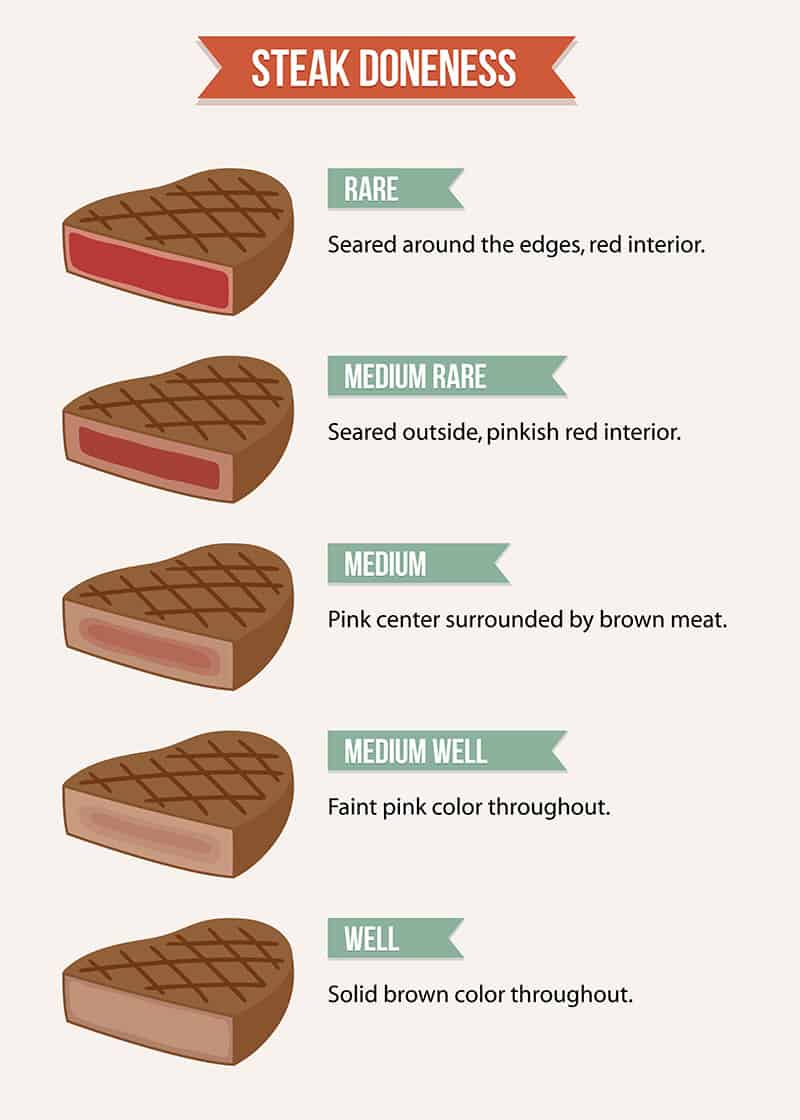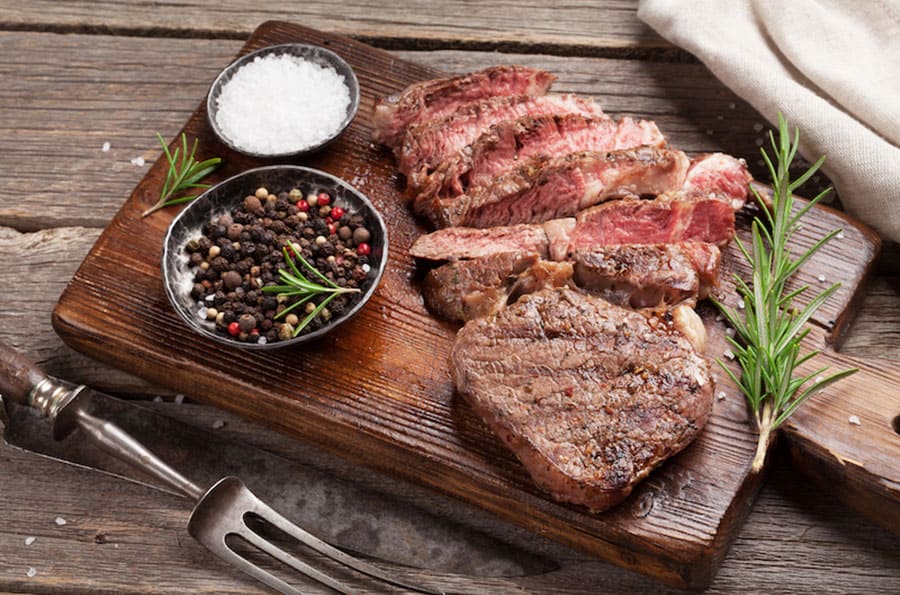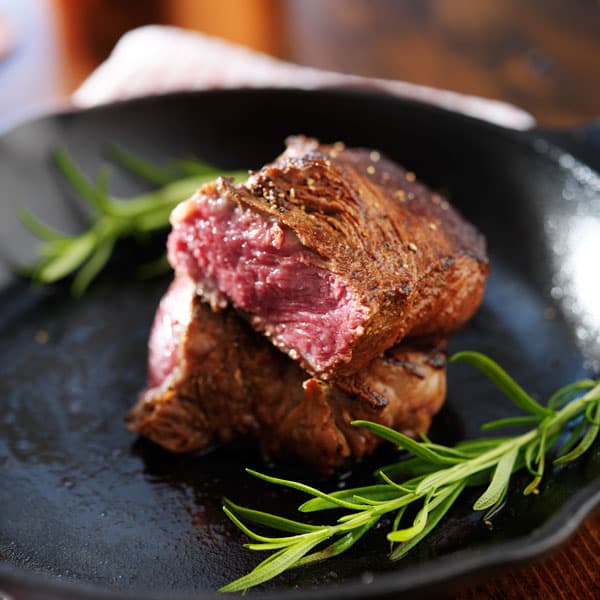Grass fed steak tends to have a beefier flavor because of the nutritional complexity pasture grass gives it, and it tends to be a little leaner than grain-fed beef. We grain-finish our steaks to add marbling and tenderness, and because it helps cattle gain weight more quickly and reliably, without sacrificing nutritional benefits as much as mass-produced supermarket meat.
How to Cook Grass Fed Steak
Meat from cattle grass-fed, even grain-finished, has less water and fat content. While grain finishing adds some fat content, cooking to perfection might be easier if you consider one of these non-traditional methods. And remember, marinades and rubs overwhelm the mellow grass-fed, grain-finished beef steak, so use it sparingly. In fact, for the absolute best steak you want it dry. Season with sea salt, pepper and other dry spices, place it on a rack and leave it in the fridge overnight, uncovered. Yep – it will sear and brown so much better if the surface of the steak is dry. And of course, make sure you take the steak out of the fridge and let it come to room temperature before you ever start cooking it.
SOUS VIDE METHOD
 Grass fed steaks cooked traditionally in a cast iron skillet or on the grill can result in an over-cooked steak. Sous vide cooking using a precision cooker will take out the guesswork and deliver a steak cooked precisely to the temperature you like – precisely on schedule. It is a gentle cooking process that achieves more evenly cooked steaks from edge-to-edge. Use this method for strip, ribeye, porterhouse, t-bone and butcher cuts of grass fed steak.
Grass fed steaks cooked traditionally in a cast iron skillet or on the grill can result in an over-cooked steak. Sous vide cooking using a precision cooker will take out the guesswork and deliver a steak cooked precisely to the temperature you like – precisely on schedule. It is a gentle cooking process that achieves more evenly cooked steaks from edge-to-edge. Use this method for strip, ribeye, porterhouse, t-bone and butcher cuts of grass fed steak.
This two-phase process involves sealing the steak in a plastic bag and cooking to the desired final temperature using a sous vide device. Phase two involves searing the meat either on the stovetop, under a broiler, or on the grill to develop color, flavor and textural contrast on the surface while helping render and soften the fat.
This method of cooking has two main pros: zero lost moisture content and temperature precision. The main con is that you need a precision device and it is more time-consuming. But with a nice thick aged cut of premium beef on the line, it might be worth the effort.

REVERSE SEAR METHOD
It is really simple to reverse-sear a steak, and it works best with at least 1.5 inches to 2-inch thick steaks. Just season and place the steak on a wire rack inside an oven-safe shallow dish. Preheat your oven to 275°F or place over indirect heat in a closed grill with only half the burners on if gas. Use a digital thermometer and cook the steak until it reaches 10° to 15°F below the temperature you like. Then remove from the rack and sear it in a piping hot cast iron skillet, on the grill over a direct high flame, or over a searing burner. We like to add a tablespoon or so of high-temp oil to the skillet before searing steak. When it starts smoking, that’s when you add the steak with a pat of butter…yum! Whole process takes less than a minute, and you can hold the steaks up with tongs to sear the sides. You can serve these steaks right away, as there is no need to rest them as with other cooking methods.
Reverse-Seared Steak (250°F Oven) |
|||
|---|---|---|---|
| Doneness | In-Oven Target | Final Target | Time in Oven |
| Rare | 105°F | 120°F | 20-25 mins |
| Med-Rare | 115°F | 130°F | 25-30 mins |
| Medium | 125°F | 140°F | 30-35 mins |
| Med-Well | 135°F | 150°F | 35-40 mins |
This method of cooking has several pros: more even cooking because the steak is gently cooked, and there is almost no overcooked meat at all so it stays juicy. It sears and browns better for a dark, crispy crust that makes a steak great. Reverse searing allows the meat to slowly heat, which simulates the enzymatic tenderization activity that makes dry-aging beef so effective. Thus, slow heating is like “rapidly aging” the steak and the result is meat that is more tender.
And finally, this method of cooking is way more forgiving. If you’ve missed that short window of time to get your perfect rare or med-rare steak before, you know exactly what this means. Slow cooking increases the timeframe for getting it just right every time. We think this method is the best of the two because sous vide steak comes out of the bag wet – making it hard to get a good sear.
One con of this method is that it takes more time than just grilling a steak the traditional way, and another is that it won’t work for thin steaks. So if a 2-inch steak is too much, just cook one and serve it to two people or save it for awesome leftover recipes the next day.
No matter how you prepare your Ozark Prime Beef grass fed steak with that awesome flavor only grain finishing delivers – it is sure to be a hit to those sharing a meal at your table1



